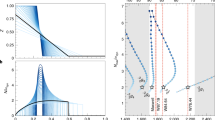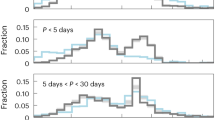Abstract
BULLEN1 has suggested that to reconcile known data for Venus, Earth and Mars with the hypothesis that they have the same overall composition, the outer core of the Earth may be composed of Fe2O. The principal reason seems to be the resolution of an alleged discrepancy between the modern solid radius of Venus determined by radar2, 6,053.7±2.2 km and the value of 6,270 km computed by Bullen on the phase-change hypothesis for the core3. But this latter value was arrived at on the basis of somewhat approximate calculations, whereas more accurate calculations4 find no discrepancy of any significance in interpreting Venus as possessed of three main zones with mechanical-elastic properties the same as in the corresponding zones of the Earth. In such calculations some allowance for the existence in Venus of a small inner core could readily be made, but it is clear that no adjustment for such an inner core, which in the Earth has volume only 0.76% of the whole, could seriously affect the computed value of the overall radius. For if the inner core were completely annihilated and the Earth contracted down geometrically without change of volume of the remainder, the outer radius would shrink only by 16 km, so that averaging of its properties with those of the main bulk of the core would produce negligible change of radius, whereas Bullen's discrepancy is over 200 km.
This is a preview of subscription content, access via your institution
Access options
Subscribe to this journal
Receive 51 print issues and online access
$199.00 per year
only $3.90 per issue
Buy this article
- Purchase on Springer Link
- Instant access to full article PDF
Prices may be subject to local taxes which are calculated during checkout
Similar content being viewed by others
References
Bullen, K. E., Nature, 243, 68 (1973).
Ash, M. E., et al., Science, 160, 985 (1968).
Bullen, K. E., Mon. Not. R. astr. Soc., 110, 256 (1950).
Lyttleton, R. A., Astrophys. Space Sci., 5, 18 (1969).
Ringwood, A. E., Geochim. cosmochim. Acta, 26, 457 (1962).
Ramsey, W. H., Mon. Not. R. astr. Soc., 110, 325 (1950).
Lyttleton, R. A., Proc. R. Soc., A, 296, 285 (1965).
Rabe, E., Astr. J., 55, 112 (1950).
Rabe, E., and Francis, M. P., Astr. J., 72, 316 and 862 (1967).
Author information
Authors and Affiliations
Rights and permissions
About this article
Cite this article
LYTTLETON, R. Structure of the Terrestrial Planets. Nature 246, 84–85 (1973). https://doi.org/10.1038/246084a0
Received:
Issue Date:
DOI: https://doi.org/10.1038/246084a0
Comments
By submitting a comment you agree to abide by our Terms and Community Guidelines. If you find something abusive or that does not comply with our terms or guidelines please flag it as inappropriate.



